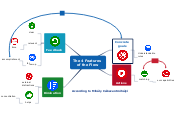Summary
What natural processes result in the levels of each of the following gases increasing?
N2O
Reactions of bacteria in soil and water
O3
Ozone gas exists naturally in the stratosphere where it forms a layer protecting Earth’s surface
CH4
Plant decomposition in swamps and animal digestion
H2O
Water Vapour cycle
CO2
Volcanoes, burning of organic matter, and cellular respiration
What is happening in the picture?
Why natural greenhouse effect is GOOD.
Natural greenhouse gases in the atmosphere accounts for the temperature difference. Heat radiation emitted by the Earth is concentrated at long wavelengths and is strongly absorbed by greenhouse gases in the atmosphere. The absorption of heat causes the atmosphere to warm and emit its own infra-red radiation. As a result, the surface temperature of the globe is around 15°C on average, 33 °C warmer than it would be if there were no atmosphere.
It is the natural greenhouse effect, some rays are being absorbed, whilst the others are being reflected back into space.
Canary in the Coal Mine
It is called this because it’s vulnerable to feedback processes which can magnify even tiny changes.
Albedo
Albedo effect
This is the positive feedback loop between ice on Earth’s surface and Earth’s average temperature.
The amount of radiation reflected by a surface.
Highest to lowest albedo
Snow, cloud, desert, forest, water.
Explain what happens to the Sun’s radiation when it strikes different surfaces on Earth. What happens as the ice melts?
TRANSMIT
REFLECT
ABSORB
It spreads and is even less direct towards the poles. The ice melts and increases the ocean levels, also more of the sun’s rays can get through with less ice to reflect it back into space, allowing for more heat to be trapped.
It spreads and is less direct towards the poles. The ice melts and increased the ocean levels, also more of the sun’s rays can get through with less ice to reflect it back into space, allowing for more heat to be trapped.
Little Ice Age
About 300 years ago, there was a period of reduced solar activity. This was called the Little Ice Age. When parts of the world became so cold that the period was called the Little Ice Age, which lasted from about 1300 to 1850.
Subtopic
Important details to determine if the world is in an Ice Age
The amount of sunlight received in the summer at high northern latitudes is important to determining if the Earth is in an Ice Age or not, When the northern summer sun is strong, the Earth is in a warm period, if it is weak the earth is in an ice age.
Milankovitch cycles
Precession (wobble)
Obliquity (tilt)
Eccentricity (elliptical)
Main topic
Volcanoes
What is discharged during a volcanic eruption?
Volcanic ash, sulfur dioxide, sulfurous aerosols, rocks, and lava.
What happened during the year without a summer?
A supervolcano erupted in Indonesia, and due to the ash, and sulfurous aerosols travelling overseas, the sun was blocked out.
Which is more likely to causes global cooling, a volcanic eruption close to the equator or one close to the poles?
Volcanoes that erupt at closer to the equator are more likely to cause global cooling because winds transport these sulfurous aerosols around the planet in easterly or westerly directions. For this reason, volcanoes that erupt at closer to the poles are less likely to cause cooling because the sulfurous aerosols are confined to wind patterns surrounding the poles.
Effect clouds have on temperature?
At a low altitude they trap thermal energy and makes the area warmer than usual.
If the clouds form at high altitudes, they will reflect the Sun’s radiation back out to space.
Water vapour impact on temperature
More water vapour usually means more clouds. If the clouds form relatively low in the atmosphere, then they trap thermal energy near Earth’s surface.
Is this positive or negative feedback?
Positive
What is the difference between a positive and negative feedback loop?
Positive feedback - effect amplifies original cause.
Negative feedback - reduces the original cause.
Grand Minimum Opinions
It will help with future global warming, but will not completely prevent it as we will still be receiving heat and have trapped excess CO2.
Aphelion
Aphelion is when the Earth spends more time during the year away from the sun.
Perihelion
Perihelion is when Earth spends more time in close proximity to the sun.
Radiative Forcing
Any factor that causes a change to Earth’s energy balance









